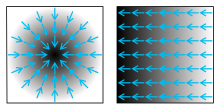
In vector calculus, the gradient is a multi-variable generalization of the derivative. Whereas the ordinary derivative of a function of a single variable is a scalar-valued function, the gradient of a function of several variables is a vector-valued function. Specifically, the gradient of a differentiable function
f
{\displaystyle f}
of several variables, at a point
P
{\displaystyle P}
, is the vector whose components are the partial derivatives of
f
{\displaystyle f}...